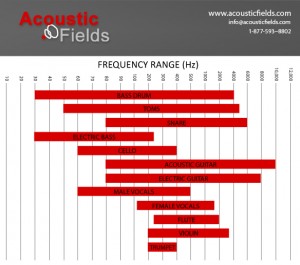Room Modes
Room modes are divided into three main groups. We have the axial, tangential, and oblique. These three major groups of room modes are defined by the surfaces they move between and the resulting havoc they cause on the sound pressure distribution in our rooms. Room modes are all about excess energy that has too few places to go.
Axial Modes
Axial modes are characterized by two waves that are going in opposite directions but traveling parallel to one axis. It is like two cars traveling on the same road. One car is going south and one car is going north. They are both on the same road or axis. They continue on their journey, then at the same time, they both strike a wall. If you are sitting in your room listening to music, the “cars” have struck your side walls. This impact creates a room mode of a certain frequency, depending on the wavelength we are looking at and the distance from your side wall to side wall. Axial modes are the most powerful and cause the greatest acoustical issues. Axial modes also have many cousins.
Tangential Modes
Next, we have the tangential modes which are created by four “cars” driving in opposite directions and on two axis. If we take the two lane driving example of axial modes and double the number of cars on the road, we can get an idea of tangential modes. This time the four “cars” split up into two cars going one way and two cars going another. They strike four walls and move parallel to two. Tangential modes have only one half the energy of axial modes. Do not let this fool you. The still have a large impact on the acoustics of our rooms. Every tangential modes, like the axial modes, has an extended family of trailing modes.
Oblique Modes
The oblique modes are exhibited by eight “cars” that travel and impact on all six surfaces of our room. They strike the four walls we are all familiar with and then strike the floor and ceiling. Oblique modes have only 25% of the energy of an axial mode and are not much of an issue when it comes to room acoustic analysis. Oblique modes are dealt with as surface reflections, with more of these reflections than axial and tangential.
Room Modes Increase
The higher up the frequency scale we go, we see an increase in the number of room modes. Our room size is also a factor. Room sizes and dimensions that match the length of our wavelengths closely contribute to this scenario. If we have a 100 Hz. wave in a room that is 11′ in one direction, we have a situation that can cause a room mode. As frequency increases, our room modes start appearing closer together. With numerous room modes grouped together and not separated by enough frequency, we get a situation that is not conducive to recording. If our vocals or music falls within these gaps, we can have exaggerated sound or no sound at all.
Musical Impact
When we are dealing with room modes of any type, we must be concerned with their attack and decay and the impact that this pressure variance has on our signal. If we have a axial mode that is giving us attitude at 40 cycles, we need to treat this axial mode with absorption. We can’t just put down carpet on our floors or attach egg crates to our wall, unless we want the room mode to laugh at us. We must determine the room mode’s magnitude and apply the correct acoustical treatment to minimize the resonances impact at our listening or monitoring position. Only powerful absorption technology can be used if we are going to take the resonance level and reduce it from an audible nightmare to a tolerable nuisance.
Not Free Speech
Room modes have a destructive impact on speech and its intelligibility. This is true because male and female speech operates in a very narrow frequency band. See the frequency range chart attached. With these narrow frequency bands of operation, we must be careful with the modes that occur within these narrow bands. If we have axial modes that are spaced apart by only 20 Hz. or are coincident which means that they are very close together and can be constant sources of coloration.
Voice Coloration
Gilford , an acoustic engineer, narrows down this acoustical impact by stating that,”axial modes can become audible when it coincides with a fundamental or first format of at least one vowel sound of speech and are in the region of high-speech energy”. A room modal resonance can impart its negativity down to the sound of one vowel in a speech pattern. This is real sound coloration where a resonance has an impact just on even a single vowel. Just imagine the other impacts on our signal if we are operating at this high degree of impact on sound coloration level.
Room modes are all about pressure inside of our rooms. Parts of the pressure is invited by the room and enjoys being there. The other part is invited but once in the room, wants to leave. Since it can’t leave, it gets upset and makes itself known through room resonances. These resonances can exaggerate certain frequencies and completely smother others. Vocals can be attacked and influenced at a single note level. Room modes must be carefully entertained within our room, so they can arrive and depart, smoothly, without any friction.






